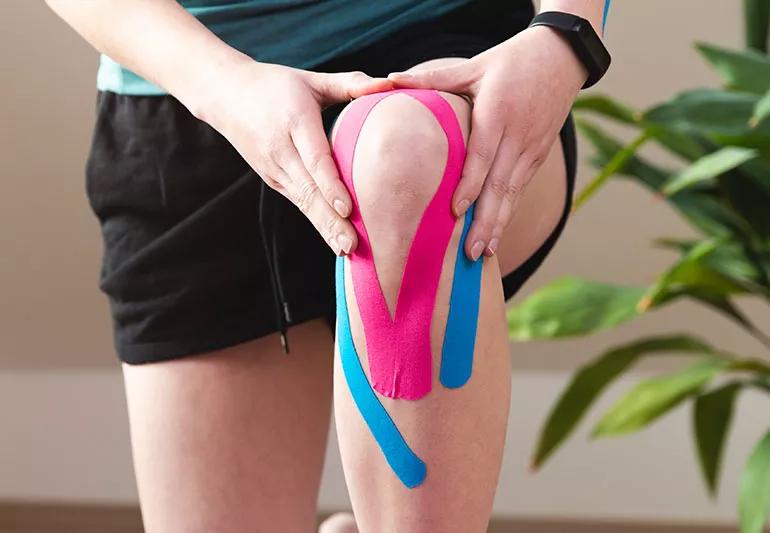An expert explains the potential benefits

You may have seen athletes with large strips of brightly colored tape placed on their skin meant to enhance their performance. Did you know the same type of tape — called Kinesio tape, elastic therapeutic tape or kinesiology tape — may have pain-relieving effects for people with osteoarthritis?
Advertisement
Cleveland Clinic is a non-profit academic medical center. Advertising on our site helps support our mission. We do not endorse non-Cleveland Clinic products or services. Policy
This tape is a stretchy cotton strip with adhesive on one side, giving you stability but with a wider range of motion than with normal athletic tape.
And the newest guidelines on treatment for osteoarthritis from the American College of Rheumatology give a conditional recommendation for Kinesio tape for hand and knee osteoarthritis. Orthopedic surgeon Dominic King, DO, walks us through the benefits and tips for this use.
“Any kind of taping is meant to help limit motion,” says Dr. King. If you have painful joints from arthritis, limiting motion can help to relieve some of the pain. “However, we always want to balance immobilization with mobilization,” he adds.
Totally immobilizing the joint can actually make it a bit stiffer. “An argument for Kinesio tape is it can limit motion, but it also is stretchy enough that you get more motion than you would from traditional tape or from wearing a brace,” says Dr. King.
All taping provides support, but with Kinesio tape, you get more dynamic support. “It’s not the stiff kind of feeling you get with traditional taping or a hard brace,” says Dr. King.
It can also help to support muscles. The muscles around a joint with arthritis typically have to work harder. Kinesiology tape can allow those muscles to relax a little.
Advertisement
Kinesio tape may help with pain, but be sure to apply it correctly. “You pull it to create some tension, but you don’t want to pull all the tension out of it,” says Dr. King. He recommends getting instruction from an occupational therapist or physical therapist.
“Most people can learn how to apply it themselves once they’ve been shown,” says Dr. King. You can purchase the tape from many retail outlets. It’s available in rolls or precut for specific applications.
“The joint that probably responds best to Kinesio tape is the carpometacarpal joint,” says Dr. King. This is the joint at the base of the thumb, which is a common location for osteoarthritis.
The tape is also conditionally recommended for osteoarthritis in the knee. Dr. King notes that it’s most effective for people with osteoarthritis in the front of the knee underneath the kneecap.
There are studies that show a reduction in pain and improvement in range of motion with Kinesio tape. However, there isn’t enough high-quality evidence to make a strong recommendation, and there are experts who doubt its effectiveness.
Nonetheless, Dr. King has no reservations about suggesting it. The risk for harm is extremely low. “I like mechanical options for mechanical problems like osteoarthritis,” says Dr. King.
Advertisement
Learn more about our editorial process.
Advertisement

Your knees could be hurting at bedtime because of inflammation, injury or some other condition that gets worse with pressure and positioning

Raspberries are packed with nutrients that can reduce inflammation and prevent chronic diseases

Adding foods like fruits, vegetables, fatty fish and whole grains to your diet may help soothe inflammation

To avoid swimmer’s eye, wear goggles, use eye drops and flush out your eyes with fresh, clean water when irritated

Eating well can help reduce inflammation when you have endometriosis

Keep kids safe while they swim by staying vigilant and setting up a safe pool environment

Whether it’s crushed ice, a chilled gel pack or frozen corn, you’ve got options

These illegal supplements have negative impacts for vital organs and may cause psychosis, heart attacks and more

Babies can get congested easily, but you can calm their cough by keeping them hydrated, using nasal drops and running a humidifier

Weight loss may cause loose, sagging skin and muscle loss to your rear

Several conditions, like vitiligo and fungal infection, can cause a loss of pigmentation, leading to white spots or patches on your skin